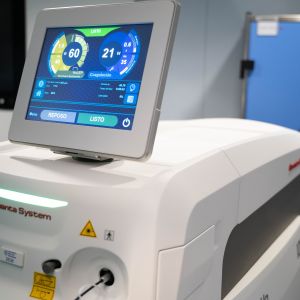Grupo Policlinica acquires a high-precision laser for urological surgeries
- The high-power laser is the most advanced tool for surgery of benign prostatic hyperplasia, a pathology that affects 51% of men over the age of 60 and more than 75% of men over the age of 80.
- The technology reduces side effects in prostate surgery by more than 50% and shortens the hospital stay from 5 days or a week to 24/48 hours.
- This laser also makes it possible to resolve urinary lithiasis more effectively, fragmenting larger stones to facilitate their expulsion.
Haemorrhages, infections, urinary incontinence or erectile dysfunction are the most common consequences of prostate surgery, although this depends on the pathology and the surgical technique used. However, the arrival of new technologies, such as the latest generation laser, recently acquired by the Policlínica Group, or robotic surgery, has radically changed this panorama. With the new minimally invasive surgical techniques, the undesired effects of prostate surgery are notably reduced, shortening the patient's stay in hospital and reducing the usual complications by approximately 50%.
Effective solution for benign prostatic hyperplasia
Among the most common prostate pathologies, along with prostatitis and prostate cancer, is enlarged or benign prostatic hyperplasia, which, although not life-threatening, is a condition that greatly affects the patient's quality of life. This condition is suffered by approximately half of all men aged 60 and over, and between 75 and 90% of men in their 80s.
Its most characteristic symptoms include a weakened urine flow, increased voiding frequency, difficulty initiating urination, overflow incontinence or complete inability to urinate. This is because the proliferation of glandular tissue causes an obstruction of the bladder outlet that results in all these bothersome symptoms.
"Until recently, prostates with hyperplasia larger than 70-80 grams - approximately 50% of the prostates we operate on - had to be operated on by open surgery, with a much longer postoperative period, a scar in the abdomen and a much greater risk of bleeding and transfusion", says Dr. David Salinas, founding partner of Uros Associats, the largest private group of specialists in Urology in Spain, associated with the Grupo Policlínica to provide a service to its patients.
Likewise, prostates smaller than 70-80 grams could previously be operated through a natural orifice (the urethra), but with another technique that also had a higher risk of bleeding, a higher rate of reoperation for complications (8.8% vs 4.3%) and a higher probability of reoperation for prostate regrowth (2% per year vs 0.7% at 10 years) compared to the new techniques, which are now used for all degrees of hyperplasia.
"The high-power laser allows interventions through the natural orifices, so there is no scar and it allows us to intervene on any size of prostate with obvious advantages for the patient," says Dr. Salinas.
High precision laser
This innovative technique is called HoLEP, Holmium Laser Enucleation, currently the most advanced technique for benign prostatic hyperplasia. Surgery with this high-precision laser makes it possible to remove the enlarged prostate tissue in its entirety, with minimal bleeding, which means that prostates of any size can be operated on with less risk. In addition, spinal anaesthesia is generally used for the procedure, and most patients leave the hospital without a catheter within a day or two, thus offering multiple advantages over open surgery.
Removal of lithiasis
Another pathology that can be effectively addressed by high-power laser is kidney or ureter stones, which, when large, usually require surgical intervention to be removed. In these cases, the laser has greatly facilitated both surgery and recovery, as the stones are pulverised by the high precision laser, favouring their subsequent expulsion. This technology makes it possible to eliminate lithiasis even in areas that are difficult to access, using much less time in the intervention and achieving a quicker and less painful recovery.
Renal lithiasis is a very common pathology that originates when solid masses are formed from the crystallisation of substances present in the urine, which can cause extremely painful symptoms. When the stones are small, they are normally expelled naturally; larger stones, on the other hand, present greater complications, requiring, in most cases, surgical intervention.


